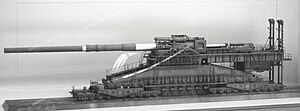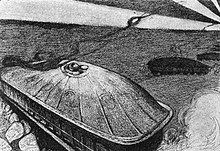Landship

The Overburden Conveyor Bridge F60 is one of the largest terrestrial vehicles by any physical dimensions.
"Landship" is a euphonious term for an unusually large example of a class of object; usually defined as a large vehicle that travels exclusively on land, as opposed to on water, air, or in space. However, the term has now been used for other subjects, examples include:
Military committees[]
- Landship Committee, a committee formed during World War I, it was designed to develop the original term of the landship[1] (large armored fighting vessels akin to naval ships) in order to deal with the trench warfare being fought over in no man's land, the British proposed building "landships" – large (1,000 tons or more) vehicles capable of crossing the trench systems of the Western Front, and the Landship Committee was formed to investigate these ideas for equipping the Naval Brigades.[2] It gained notable support of Winston Churchill.[3]
Military vehicles[]

Schematic for the T-42 Soviet tank
- Tank, the tank was originally referred to as the Landship, owing to the continuous development from the Landship committee. The concept of a 1,000 ton armored fighting machine on land quickly became too impractical and too costly for it to be realistically conceived.[4] As such, the landship project first began proposing a revised vehicle that was cut down considerably in size. The first conceptual tank prototypes was for a vast 300-ton vehicle that would be made by suspending a 'sort of Crystal Palace body' between three such enormous devices.[5] These so-called six 'Big Wheel' landships were eventually commissioned. However, even at a revised weight, 300 tons was still considered wholly impractical given the technology present, but the influence of the big wheel would persist in the 'creeping grip' tracks of the first tanks, which were wrapped around the entire body of the machine.[5]
- Mark I tank, the constant revision eventually led to the creation of the first tank. Granted, whilst the Mark 1 and later variations was far smaller than the initial behemoths envisioned, they still used naval guns such as the QF 6-pounder Hotchkiss which was later shortened into the QF 6-pounder guns.

Model of the Dora, sister railway gun of the Schwerer Gustav.
- Schwerer Gustav, a super heavy Railway Gun that was the largest gun by both tonnage and calibre that was fired in an actual war. Created by Nazi Germany, the Schwerer Gustav along with its sister guns, Dora and Langer Gustav, was the largest railway gun, not to mention railway vehicle to be ever constructed as well as the single-most largest terrestrial combat artillery vehicle in World War II. At the length of 47.3 metres (155 ft 2 in), a width of 7.1 metres (23 ft 4 in) and a height of 11.6 metres (38 ft 1 in), the Schwerer Gustav weighed a monstrous 1,350 tonnes. It was so big and so specialised, that it required its own diesel-powered generator to provide power to run its systems, its own special railway track to support its gargantuan size and required an oversized crew of 2,750 (250 to assemble and fire the gun in 3 days and 2,500 to lay the tracks). By definition, the Schwerer Gustav would have qualified as a landship, albeit one limited on rails.
- Super-heavy tank, extremely large tanks, concepts of which led to gargantuan vehicles rivaling naval warships. Superheavy tanks such as the British TOG2 and the Soviet T-42 were structured in a similar layout of naval battleships, albeit on a smaller scale.

- Landkreuzer P. 1000 Ratte, a super heavy tank that was called a land cruiser by Nazi Germany. The closest humanity got in creating the classical landship concept. The Ratte, if it was to be physically completed, would have been 35 meters (115 feet) long, 14 meters (46 feet) wide, and 11 meters (36 feet) high with a weight of 1,000 tons.[7] Moreover, its primary armament would have had naval guns along with two machine guns and eight anti-aircraft guns, 8.1 kg (18 pounds).[8]
- Landkreuzer P. 1500 Monster, a super-heavy self-propelled gun that was also devised by Nazi Germany, the Monster would be even bigger than Ratte at 1,500 tons. The self-propelled gun would have mounted the aforementioned colossal Schwerer Gustav.[9]
Parades and events[]
- Barbados Landship, a Barbadian cultural tradition and event that mimics the British Navy.
Civilian vehicles[]

The Bagger 288 bucket-wheel excavator
- Antarctic Snow Cruiser, a very large vehicle designed to explore Antarctica, however was ultimately a failure.
- Bucket-wheel excavators, large civilian mining vehicle, of which Bagger 293 remains the heaviest land vehicle ever made. Their large size have often made BWEs be compared to ocean liners on land.[10][11]
- Conveyor bridges, extraordinarily large mining vehicles that convey overburden in open-pit mining. The Overburden Conveyor Bridge F60 is considered the largest vehicle in physical dimensions of any type and has been referred to as a 'lying Eiffel Tower'.[12][13]
- Bucket chain excavators, cousins of the BWEs, BCEs although smaller, are of the same category in terms of size.
- Dragline excavators, extremely large excavators that moves by 'walking' on two pneumatic feet. The Big Muskie was one of the largest terrestrial vehicles ever built.
- Extremely large Power shovels, such as The Captain rivaled BWEs and dragline excavators in sheer size.[14]
- Tunnel boring machines, are large underground vehicles that are designed to drill and create subterranean subway transits, some of which weighs around 5,000 tons.
- The NASA Crawler-transporter is an ultra-heavy transporter used to ferry spacecraft to the launching pad. At 2,000 tons each, they are the largest ground vehicle that still uses an internal combustion engine as its source of propulsion, rather than being reliant on an external power source.
- Breitspurbahn, a proposed civilian railway line envisioned by Adolf Hitler, these super enlarged transit lines would have accommodated for ultra-wide trains that would be 500 meters long.
- Land yacht, a terrestrial equivalent of the naval yacht, despite this, it is not as large as its naval cousin due to the limitation on sailing on land.
Design concepts[]
- The Walking City, a form of drivable arcologies that has been conceptualized.[15][16]
Fictional examples[]

1904 illustration of H.G. Wells' The Land Ironclads, showing huge ironclad land vessels, equipped with pedrail wheels
- "The Land Ironclads", one of the first examples of the landship concept. Created by science fiction author, H.G. Wells, this was the most prominent and influential fictional landship as it helped inspired the Landship Committee and in turn, the tank and other armored fighting vehicles prior to World War 1.[17][18]
- In the Mortal Engines series, large landships called 'traction cities', hunt smaller vehicles in the theories of Municipal Darwinism.
- In Homeworld: Deserts of Kharak, literal land-bound aircraft carriers and land battleships are the primary mode of transporting firepower and air power in the largely desert terrain of the world of Kharak.
- In Warhammer 40,000, large land battleships such as the Capitol Imperialis and the Colossus battle giant mechs known as Titans.
- The Halo franchise used large terrestrial vehicles that are analogues to landships as troop transports such as the Mammoth or Elephant.
- In Haze, the main base of operations for the protagonist is a large, mobile terrestrial aircraft carrier.
- In Star Wars the Jawas use the Sandcrawlers as a mobile base of operations.
- In the Fallout universe, the Enclave faction used a modified crawler-transporter as a mobile base of operations.
- The Dystopian Wars wargame and miniature series is set in an alternate history where steampunk technology has advanced to the point that almost every major nation has access to functional landships.
See also[]
- Seaship - seacraft simply known as a ship; large waterborne vessels used for commerce, maritime trade and naval expeditions.
- Airship - large aircraft and are the airborne equivalent of naval vessels, mostly used for weather and scientific research purposes.
- Spacecraft - large vehicles used to transport objects into space, can be split into expandable rockets or reusable spaceplanes.
- Landship Committee
- Road train
- Armoured train
- Super-heavy tank
- Tsar tank
References[]
- ^ Fletcher, David (1984). Landships: British Tanks in the First World War. HMSO. ISBN 0-11-290409-2.
- ^ Ogorkiewicz, Richard Marian. "tank". Encyclopedia Britannica. Retrieved 26 February 2022.
- ^ Frost, Marcus (30 April 2016). "Churchill's 'Landship': The Tank". The Churchill Project. Hillsdale College. Retrieved 26 February 2022.
- ^ Richard Ogorkiewicz (20 February 2015). Tanks - 100 Years of Evolution. pp. 29–31. ISBN 9781472813053.
- ^ a b Patrick Wright. "Tank: Life and Times of a 'Wonder Weapon'".
- ^ Kyle Mizokami (18 April 2018). "Russian Museum Recreates WWII-Era 'Land Battleship'".
- ^ Ruslan Budnik (12 November 2018). "The Ridiculous 1000 Ton Landkreuzer P.1000 "Ratte"".
- ^ "Krupp Landkreuzer P.1000 Ratte (Rat)".
- ^ "Krupp Landkreuzer P.1500 Monster".
- ^ Largest Dams. Bucket Wheel Excavator (Bagger 293). Archived from the original on 2014-02-26.
- ^ Peter Sciretta (27 October 2016). "Westworld: Dr. Ford's Gigantic World Sculpting Machine Is A Real Thing".
- ^ "Overburden Conveyor Bridge".
- ^ "Overburden Conveyor Bridge F60".
- ^ Jeff Dean (5 September 2012). "Iron Profile: Marion 6360 Shovel "The Captain"".
- ^ "Nomadic Urbanism: Futuristic 'Walking City' Draws on History". 7 January 2014.
- ^ Lucy Wang. "Amazing "Green Machine" Mobile City Concept Transforms Deserts into Lush Oases".
- ^ Charles E. Gannon (2005). Rumors of War and Infernal Machines. pp. 62–63. ISBN 9780742540354.
- ^ H. G. WELLS. "THE LAND IRONCLADS".
Categories:
- Engineering vehicles
- Armoured fighting vehicles
- Off-road vehicles